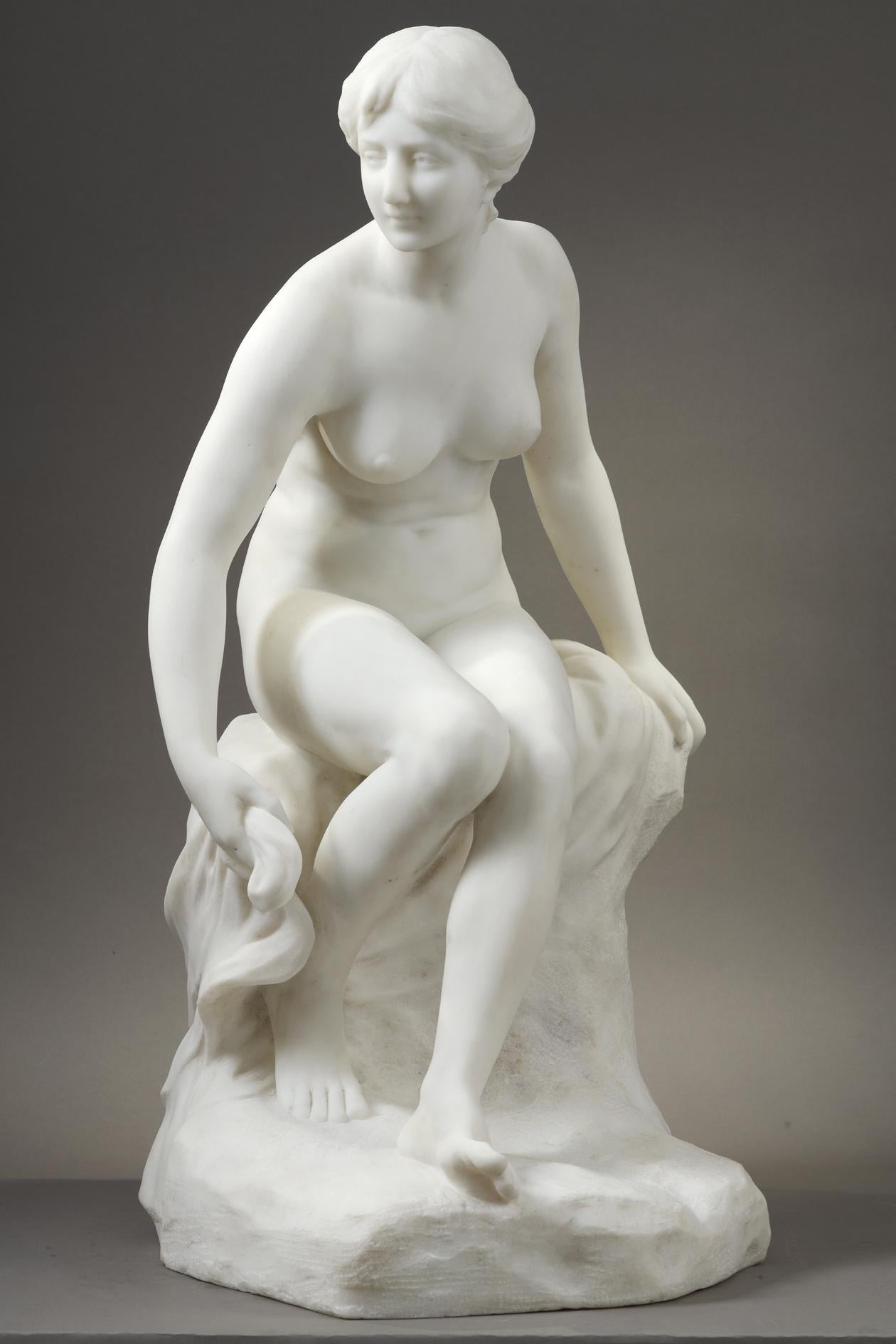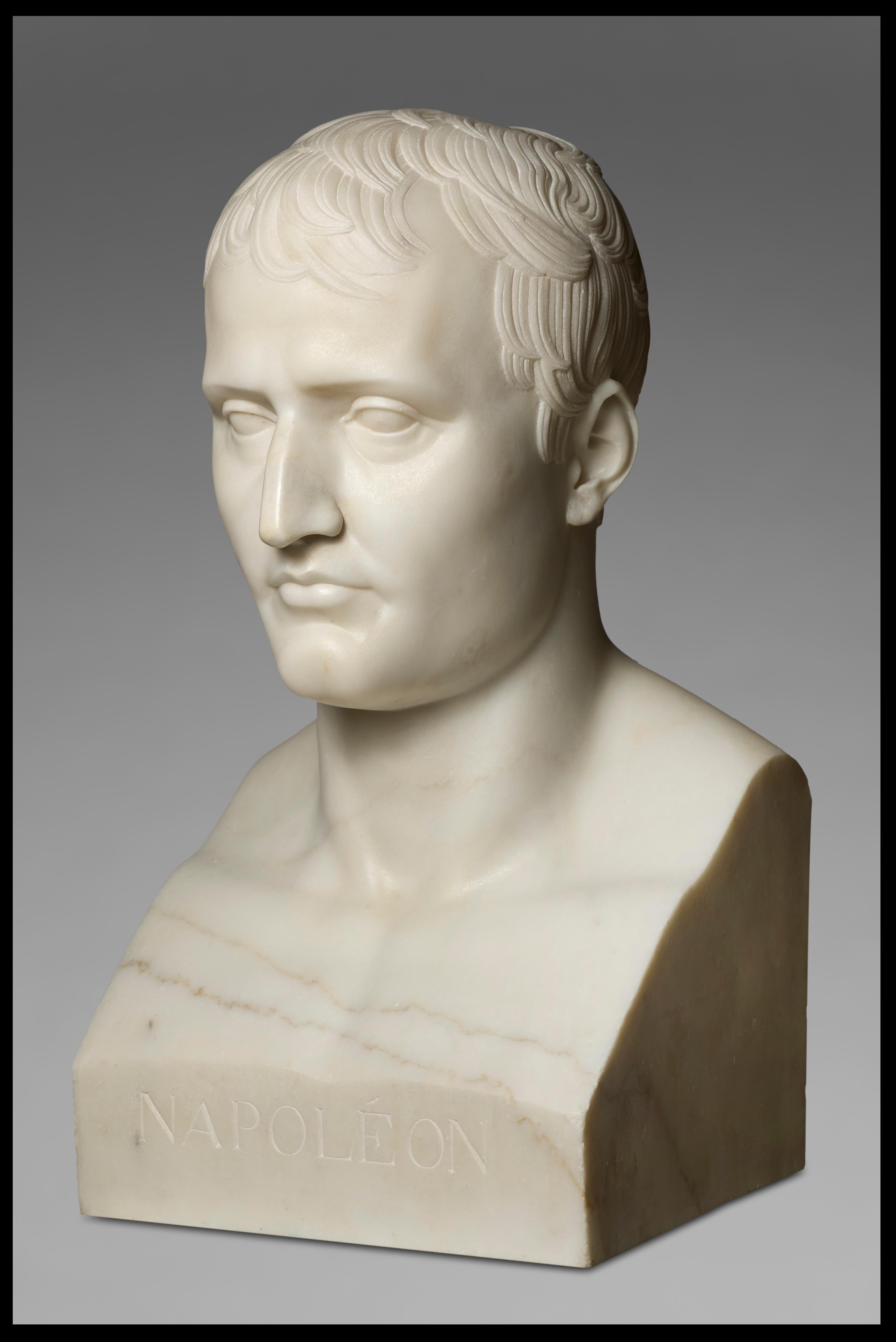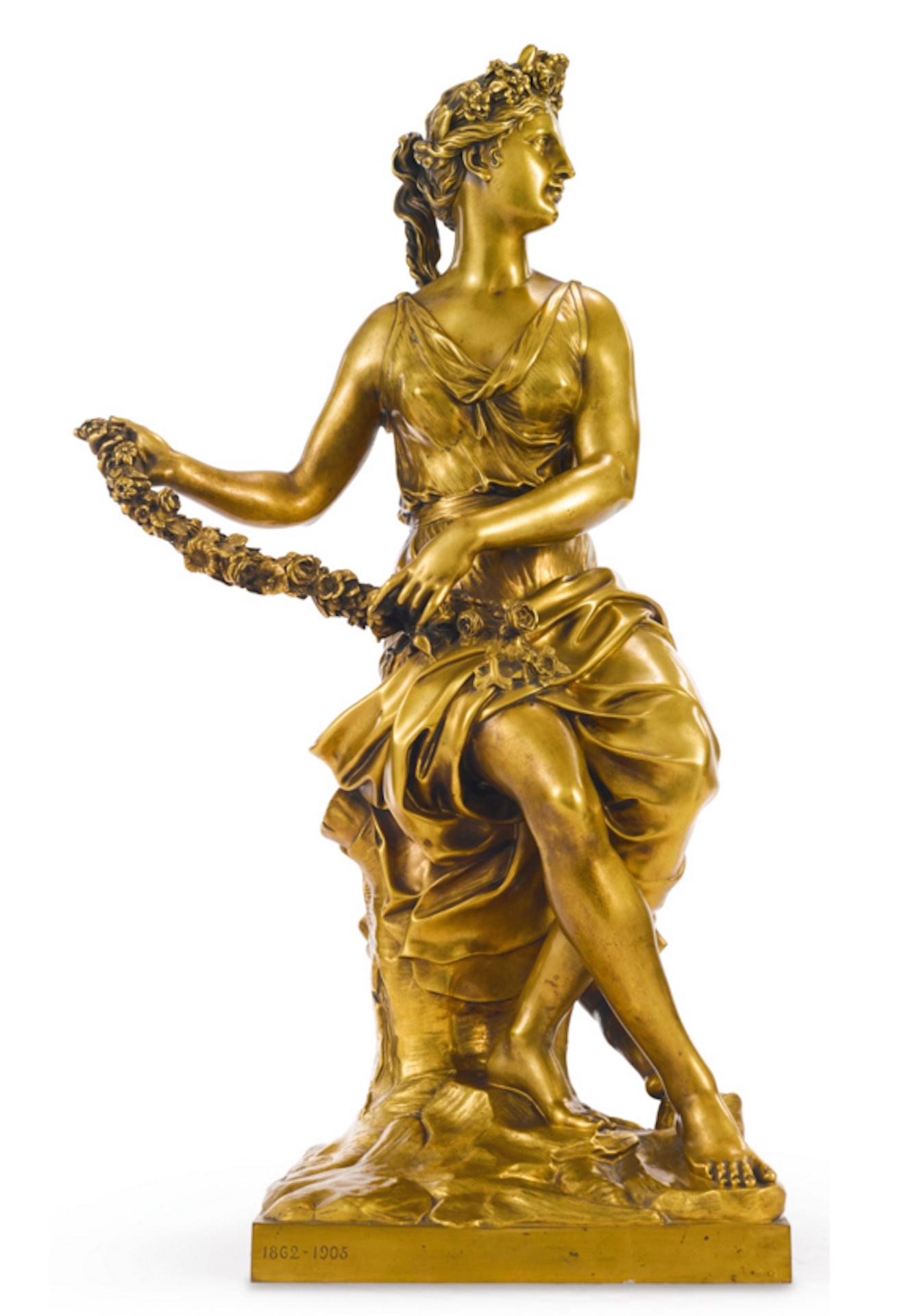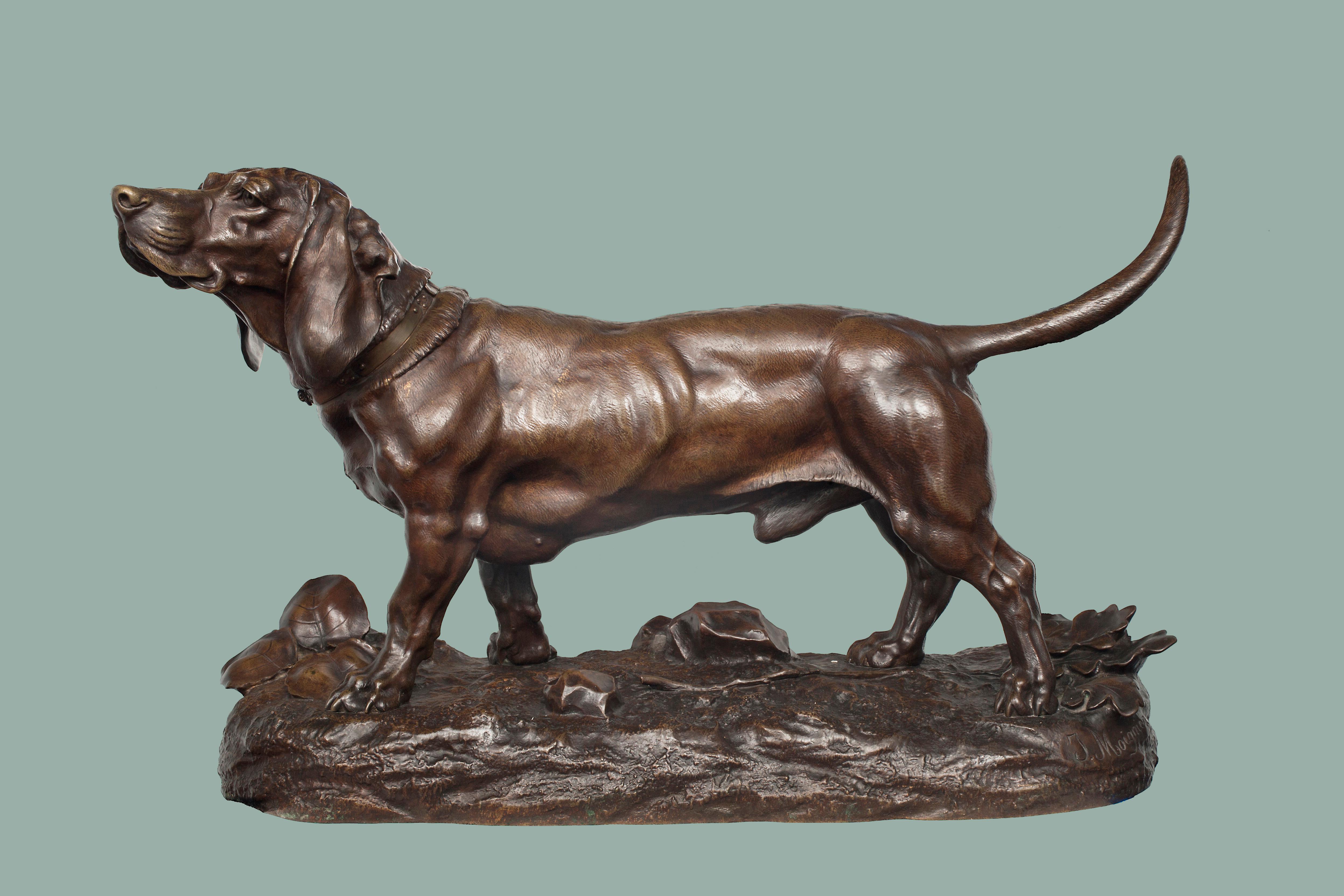Items Similar to Antique French Grand Tour Gilt Bronze Statue on Column Diana the Huntress 1838
Want more images or videos?
Request additional images or videos from the seller
1 of 21
Ferdinand BarbedienneAntique French Grand Tour Gilt Bronze Statue on Column Diana the Huntress 1838circa 1838
circa 1838
About the Item
A fine & large (34" tall) antique French gilt-bronze on marble column of Diana, cast by Ferdinand Barbedienne (1810-1892) after a statue by Jean Antoine Houdon (1741-1828), the bronze circa 1838.
This very elegant neo-classical bronze depicts Diana the Huntress carrying a bow and arrow, she is raised on a black marble column with an ornate Corinthian capital and a corresponding bronze plinth. The top of the column is signed "F. Barbedienne Fondeur" and also "Houdon".
Ferdinand Barbedienne and Achille Colas (1795-1859) in 1838 developed a process to make very high quality bronze statues. This is a very early example from the beginning of their partnership.
The bronze is very beautiful, it is in very good condition, with no damage or restoration.
- Creator:Ferdinand Barbedienne (1810 - 1892, French)
- Creation Year:circa 1838
- Dimensions:Height: 34 in (86.36 cm)Width: 5.5 in (13.97 cm)Depth: 5.5 in (13.97 cm)
- Medium:
- Movement & Style:
- Period:1830-1839
- Condition:Condition is very good indeed!
- Gallery Location:Portland, OR
- Reference Number:
About the Seller
4.3
Vetted Seller
These experienced sellers undergo a comprehensive evaluation by our team of in-house experts.
Established in 1990
1stDibs seller since 2020
22 sales on 1stDibs
- ShippingRetrieving quote...Ships From: Portland, OR
- Return PolicyA return for this item may be initiated within 14 days of delivery.
More From This SellerView All
- Antique Italian Grand Tour Bronze Marble Bust Sculpture Dante Alighieri 1880Located in Portland, ORA good antique Italian Grand Tour Bronze and marble bust of Dante Alighieri, circa 1880. The bronze is most likely Florentine and mod...Category
Late 19th Century Italian School Figurative Sculptures
MaterialsMarble, Bronze
- Franz Bergmann Orientalist Arab Slave Nude Group Cold Painted Bronze Signed 1910By Franz BergmannLocated in Portland, ORA very large 24" (61cm) Franz Xavier Bergmann (1861-1936) cold painted bronze group statue, signed, Austria, circa 1910. The bronze in the Orientalist manner & depicts a young slave ...Category
1910s Art Nouveau Figurative Sculptures
MaterialsBronze
- Antique French Art Nouveau Bronze Female Bust "Phryne" Emanuel Villanis 1900By Emmanuel VillanisLocated in Portland, ORAntique, Art Nouveau bronze of a beautiful maiden in the Neo-Classical manner by Emmanuel Villanis, Circa 1900. The bronze, titled "Phryne" depicts a beautiful Neo-Classical maiden, ...Category
Early 1900s Art Nouveau Figurative Sculptures
MaterialsBronze
- Large Antique Vienna Bronze Orientalist Camel Rider Statue Sculpture Carl KaubaBy Carl KaubaLocated in Portland, ORA large cast Vienna bronze in the Orientalist style by the Austrian sculptor Carl Kauba (1865-1922). The bronze finely modeled as an Arabian dromedary camel...Category
Early 20th Century Art Deco Figurative Sculptures
MaterialsBronze
- Antique French Art deco Leaping Stag Bronze Statue Sculpture Bronze marble 1925By Georges H. LaurentLocated in Portland, ORA fine & large antique French Art Deco Bronze leaping stag sculpture/statue, by Georges H. Laurent (1880-1940), circa 1925. Georges H. Laurent was known for his animal subjects and t...Category
1920s Art Deco Figurative Sculptures
MaterialsBronze
- Pablo Picasso Terracotta Fish Pitcher Madoura Pottery Sujet Poisson France 1952By Pablo PicassoLocated in Portland, ORPablo Picasso (1881-1973), terracotta fish pitcher. Madoura pottery 1952. This original terracotta fish pitcher was created by Picasso in 1952 and was ...Category
1950s Surrealist Figurative Sculptures
MaterialsTerracotta
You May Also Like
- BatherLocated in PARIS, FRBather by Etienne Hachenburger (19th-20th C.) Sculpture in white Carrara marble Signed on the side of the base "E. Hachenburger" A simiilar model was exhibited at the Paris Salon oh...Category
Early 1900s French School Nude Sculptures
MaterialsMarble
- The SpringBy Albert-Ernest Carrier-BelleuseLocated in PARIS, FRThe Spring by Albert-Ernest CARRIER-BELLEUSE (1824-1887) Sculpture made in white Carrara marble signed on the base "A. Carrier-Belleuse" France circa 1870 height 76,5 cm width 30 cm depth 24 cm Biography : Albert-Ernest Carrier de Belleuse known as Carrier-Belleuse (1824-1887) was one of the most prolific artists of the century and had the greatest successes under the Second Empire, enjoying the personal support of Napoleon III. His work was greatly influenced by the style of the Italian Renaissance and that of the 18th century, which he helped to bring up to date. In 1837, the young Carrier-Belleuse apprenticed in the workshop of the engraver Bauchery. He was admitted soon after to the goldsmith Jacques Henri Fauconnier. Through François Arago, he met the sculptor David d'Angers who facilitated his admission to the School of Fine Arts. Carrier-Belleuse entered it in 1840. Noted for his skill by the great bronze companies in Paris such as Barbedienne and Denière, he soon received numerous orders for models for candelabras, pendulums, fittings for fireplaces, etc. In 1848, probably at the initiative of François Arago, who became head of state, he received his first public order for a small statue of "Mademoiselle Rachel singing La Marseillaise". In 1851, he appeared for the first time at the Salon of French Artists, where he presented two bronze medallions. From 1851 to 1855, Carrier-Belleuse stayed in England, in Stoke-on-Trent where he served as director of the modeling and drawing school of the Minton house, a large porcelain manufacturer. Back in France, Carrier-Belleuse moved to Paris in a large workshop located 15 rue de la Tour d´Auvergne. From 1857, he made regular sendings to the Salon and became famous thanks to the success of large marbles, such as the "Bacchante" exhibited at the Salon in 1863, and acquired by Napoleon III, "Angelica" (1866) or even "Hebe asleep" (1869). At the Salon of 1867, his group entitled "Messiah" earned him the medal of honor of sculpture. It was acquired by the State to adorn the Chapel of the Virgin in the Saint-Vincent-de-Paul church. Carrier-Belleuse acquired a great reputation in parallel for his terracotta busts which, in many respects, recall those of 18th century artists. He made portraits of a large number of celebrities of his time. He produced, among others, the busts of Napoleon III, Renan, Thiers, Grévy, Arago, Marguerite Bellanger, Théophile Gautier, Honoré Daumier, Delacroix, Hortense Schneider, Réjane… He also modelled numerous busts of mythological inspiration and historical and artistic portraits like Marie Stuart, Shakespeare or even Mozart. Carrier-Belleuse used and trained in his workshop in the rue de la Tour d´Auvergne many young talented artists such as Alexandre Falguière, Jules Desbois, Eugène Delaplanche, Jules Dalou or Joseph Chéret; but he was best known for having been the master of Auguste Rodin who entered his studio as a practitioner in 1864. Carrier-Belleuse devoted himself a lot to decorative sculpture. He contributed to the decorations of many important buildings. We owe him in particular the caryatids of the Renaissance theater in Paris, the pediment of the main entrance to the Banque de France, the stucco ceilings of the Lesdiguières and La Trémoïlle pavilions at the Louvre Palace, the frieze of the Palais de la Bourse in Brussels, or the decoration of the Hôtel de la Païva on the Champs-Elysées in Paris. He also received State commissions for monuments: that of Jean-Jacques Rousseau in Montmorency, of Alexandre Dumas, in Villers-Cotterêts, of Masséna in Nice. Abroad, he produced the equestrian statue of Michael the brave in Bucharest and the tomb of José de San Martín in Buenos Aires. In 1873, Carrier-Belleuse took part in the construction of the Paris Opera house, directed by his friend Charles Garnier. He created the two monumental torchieres...Category
1870s French School Figurative Sculptures
MaterialsMarble
- Napoleon IstLocated in Paris, FRAntoine-Denis CHAUDET (1763 - 1810) NAPOLEON Ist, circa 1808 Carrare Marble - First Empire Hermes Bust of Napoleon Ist, after Antoine-Denis CHAUDET Dimen...Category
Early 1800s French School Figurative Sculptures
MaterialsMarble
- Flora et L'amour ou HamadryadeBy Ferdinand BarbedienneLocated in Tallinn, EEFerdinand Barbedienne (1810 - 1892) Antoine Coysevox, after (France, 1640-1720) Flora et L'amour ou Hamadryade Inscribed 'A. COYSEVOX. F. 1710'. With foundry mark 'F. BARBEDIENNE...Category
Late 19th Century French School Figurative Sculptures
MaterialsBronze
- A Basset HoundBy Jules MoigniezLocated in New York, NYinscribed J. Moigniez bronze with brown patina, cast during the artist’s lifetime height 18 1⁄2 inches (47 cm.), width 29 1⁄8 inches (74 cm.) PROVENANCE James Graham & Sons, Inc., N...Category
Late 19th Century French School Figurative Sculptures
MaterialsBronze
- Hay PickerBy Aimé-Jules DalouLocated in PARIS, FRThis Peasant resting is a subject that is included in the famous suite commonly called "little workers" by Jules Dalou (1838-1902) Bronze with nuanced dark brown patina cast by Susse Frères - stamped with the founder's seal France created around 1890 and cast after his death height 12,5 cm A similar model reproduced inJules Dalou, le sculpteur de la République, Exhibition held at the Musée du Petit Palais, Paris, 2013, page 288, n°220. Biography : Aimé-Jules Dalou, said Jules Dalou (1838-1902) was a French sculptor, born from Protestants glovers craftsmen who raised in secularism and love of the Republic. Jules Dalou was very young talented for modeling and drawing, which earned him the attention of Jean-Baptiste Carpeaux, who made him entered in 1852 in the Little School, the future National School of Decorative Arts in Paris. In 1854, he was admitted to the School of Fine Arts in Paris, where he studied painting in the workshop of Abel de Pujol and sculpture in the workshop of Francisque Duret...Category
Late 19th Century French School Figurative Sculptures
MaterialsBronze



